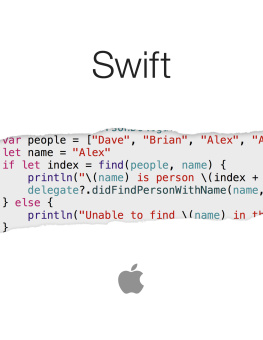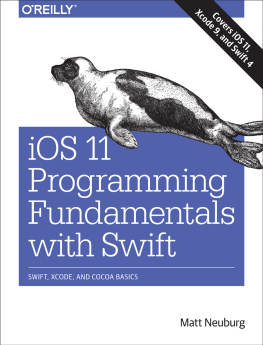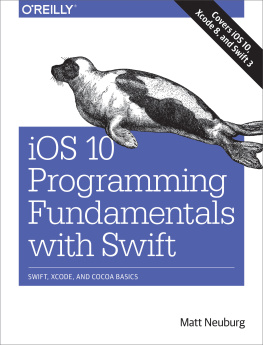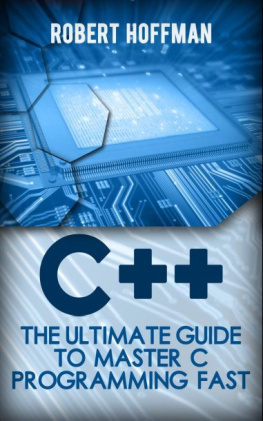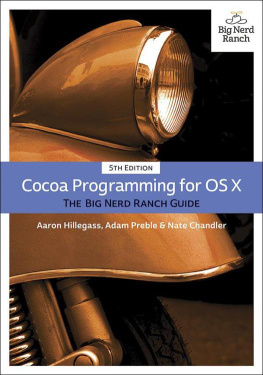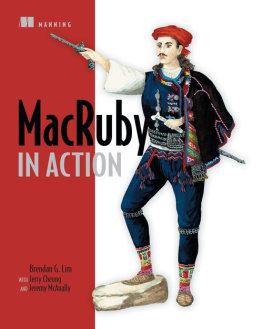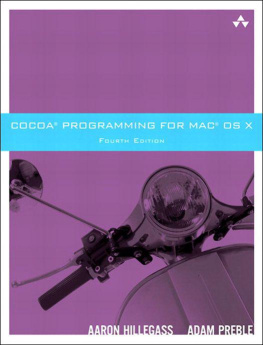David Chisnall - Cocoa Programming Developers Handbook
Here you can read online David Chisnall - Cocoa Programming Developers Handbook full text of the book (entire story) in english for free. Download pdf and epub, get meaning, cover and reviews about this ebook. year: 2010, publisher: Pearson Education Limited (US titles), genre: Computer. Description of the work, (preface) as well as reviews are available. Best literature library LitArk.com created for fans of good reading and offers a wide selection of genres:
Romance novel
Science fiction
Adventure
Detective
Science
History
Home and family
Prose
Art
Politics
Computer
Non-fiction
Religion
Business
Children
Humor
Choose a favorite category and find really read worthwhile books. Enjoy immersion in the world of imagination, feel the emotions of the characters or learn something new for yourself, make an fascinating discovery.

- Book:Cocoa Programming Developers Handbook
- Author:
- Publisher:Pearson Education Limited (US titles)
- Genre:
- Year:2010
- Rating:4 / 5
- Favourites:Add to favourites
- Your mark:
- 80
- 1
- 2
- 3
- 4
- 5
Cocoa Programming Developers Handbook: summary, description and annotation
We offer to read an annotation, description, summary or preface (depends on what the author of the book "Cocoa Programming Developers Handbook" wrote himself). If you haven't found the necessary information about the book — write in the comments, we will try to find it.
Cocoa Programming Developers Handbook — read online for free the complete book (whole text) full work
Below is the text of the book, divided by pages. System saving the place of the last page read, allows you to conveniently read the book "Cocoa Programming Developers Handbook" online for free, without having to search again every time where you left off. Put a bookmark, and you can go to the page where you finished reading at any time.
Font size:
Interval:
Bookmark:

Upper Saddle River, NJ Boston Indianapolis San Francisco
New York Toronto Montreal London Munich Paris Madrid
Capetown Sydney Tokyo Singapore Mexico City
Cocoa Programming Developers Handbook
Copyright 2010 Pearson Education, Inc.
All rights reserved. No part of this book shall be reproduced, stored in a retrieval system, or transmitted by any means, electronic, mechanical, photocopying, recording, or otherwise, without written permission from the publisher. No patent liability is assumed with respect to the use of the information contained herein. Although every precaution has been taken in the preparation of this book, the publisher and author assume no responsibility for errors or omissions. Nor is any liability assumed for damages resulting from the use of the information contained herein.
ISBN-13: 978-0-321-63963-9
ISBN-10: 0-321-63963-4
Editor-in-Chief
Mark L. Taub
Managing Editor
John Fuller
Full-Service Production Manager
Julie B. Nahil
Technical Reviewer
Gregory
Casamento
Book Designer
Gary Adair
Composition
David Chisnall
Library of Congress Cataloging-in-Publication Data
Chisnall, David.
Cocoa programming developers handbook / David Chisnall.
p. cm.
Includes index.
ISBN 978-0-321-63963-9 (pbk. : alk. paper) 1. Cocoa (Application development environment) 2. Object-oriented programming (Computer science) 3. Application program interfaces (Computer software) 4. Mac OS. I. Title.
QA76.64.C485 2010
005.268dc22
2009042661
Printed in the United States on recycled paper at Edwards Brothers in Ann Arbor, Michigan.
First Printing December 2009
Trademarks
All terms mentioned in this book that are known to be trademarks or service marks have been appropriately capitalized. Pearson cannot attest to the accuracy of this information. Use of a term in this book should not be regarded as affecting the validity of any trademark or service mark.
Warning and Disclaimer
Every effort has been made to make this book as complete and as accurate as possible, but no warranty or fitness is implied. The information provided is on an as is basis. The author and the publisher shall have neither liability nor responsibility to any person or entity with respect to any loss or damages arising from the information contained in this book.
Bulk Sales
Pearson offers excellent discounts on this book when ordered in quantity for bulk purchases or special sales. For more information, please contact us by phone or email:
U.S. Corporate and Government Sales
1-800-382-3419
For sales outside of the U.S., please contact the International Sales group:
International Sales
This book aims to serve as a guide to the Cocoa APIs found on Mac OS X. The core frameworks are described in detail, as are many of the other components used to build rich applications.
These APIs are huge. In most Cocoa programs, you include the Cocoa.h header, which imports the two core frameworks that make up Cocoa. This header, when preprocessed, including all of the headers that it references, is well over 100,000 lines long. If you printed the preprocessed header out, you would get something over twice as long as this book, and you would still only have the core APIs, and not any of the more advanced parts discussed in later parts of this book.
This book aims to provide a guided tour, indicating features of interest to help visitors find their way around this enormous family of APIs. As with many travel books, this aims to include the same must-see destinations that everyone will visit as well as some of the more interesting but often-overlooked parts.
Deep familiarity with something like Cocoa only comes from years of practice using the classes that are included as part of the frameworks. This book provides an introduction, but you will only become an expert OS X developer if you take the information contained in these pages and apply it, developing your own applications.
This book is aimed at people wanting to learn how to develop applications using the rich Cocoa APIs on OS X. It is not aimed at people wanting to learn iPhone development. The iPhone SDK is designed to be easy to learn for seasoned Mac programmers, and shares a lot of core concepts and frameworks with the desktop APIs, but it is a separate system. Reading this book will make it easy for you to learn iPhone development later and care has been taken to point out places where the desktop and mobile APIs diverge; however, this book does not cover the iPhone APIs directly.
If you want to learn how to develop rich applications for Mac OS X then this book will help you. This includes coverage of the core APIs that have remained largely unchanged since the early 1990s on NeXT workstations up to the latest additions for integration with an internetworked environment and handling rich multimedia content.
This book assumes some general knowledge of programming. The first chapters include an introduction to the Objective-C, which should be sufficient for readers already familiar with languages like C or Java. This section is not intended as a general introduction to programming concepts.
This book is divided into seven parts. Each covers part of the Cocoa APIs.
covers the background of Cocoa, how it fits into OS X, and where it came from. This part introduces and describes the Objective-C language and provides the reader with an overview of the tools used to create Cocoa applications.
In you will be introduced to the Foundation and Application Kit frameworks that form the core of the Cocoa APIs. Foundation provides low-level, core functions, while the Application Kit is layered on top and provides the features needed to build rich applications. This part introduces both, giving an overview of how they fit together and how to begin creating applications using them. You will see the basic concepts that underlie the Cocoa application model, including how events are delivered and how the drawing model works. By the end of this part you will understand how to create simple applications using Cocoa.
covers developing document-driven applications with Cocoa. A document driven application is one that creates identical windows representing some persistent model, typically a file. Cocoa includes a lot of code to support this kind of application. You will also be introduced in this part to the Core Data framework, which handles automatic persistence for documents.
goes deeper into the Application Kit. You will learn about the more advanced view objects that interact with your program via a data source and will learn how to provide data dynamically to them. You will also see how to create new view objects.
The next part, part will also take a small diversion from the visual into the audio world and discuss how to provide audible feedback to your user interface. This includes using the speech recognition and synthesis APIs on OS X. By the end of this part, you should be able to write complex multimedia Cocoa applications.
focusses on the parts of OS X that make an application feel like a part of the environment, rather than an isolated program. This includes integration with the systemwide search facilities as well as the various shared data stores, such as the address book and calendar.
Font size:
Interval:
Bookmark:
Similar books «Cocoa Programming Developers Handbook»
Look at similar books to Cocoa Programming Developers Handbook. We have selected literature similar in name and meaning in the hope of providing readers with more options to find new, interesting, not yet read works.
Discussion, reviews of the book Cocoa Programming Developers Handbook and just readers' own opinions. Leave your comments, write what you think about the work, its meaning or the main characters. Specify what exactly you liked and what you didn't like, and why you think so.


